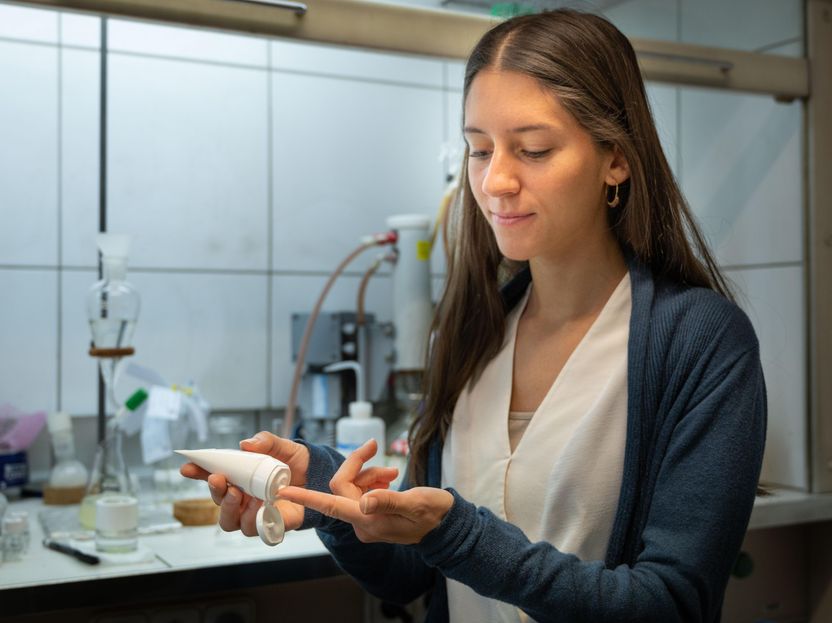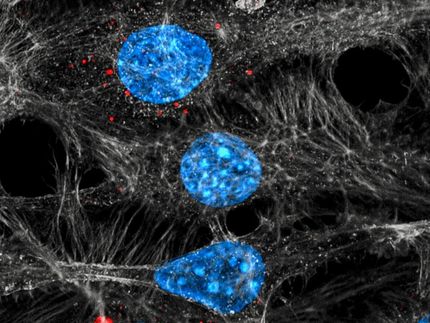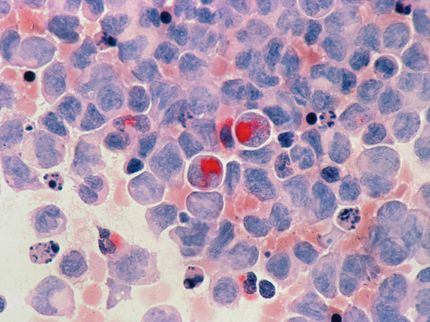CSIC scientists develop two creams to alleviate skin hypersensitivity associated with chemotherapy
In collaboration with the UMH and the CSIC spin off Alodia Farmacéutica, they have developed two 'neurocosmetics' for hands and feet that are already on the market
A team of researchers from the Spanish National Research Council (CSIC), in collaboration with the Miguel Hernández University and the CSIC spin-off company Alodia Farmacéutica, has developed two hand and foot creams, already available in pharmacies, that soothe skin hypersensitivity in cancer patients. The use of chemotherapeutic agents for the treatment of different types of cancer carries a high risk of neurological and motor complications, characterized by mechanical and cold hypersensitivity and numbness of hands and feet.

Researcher Teresa Vázquez Rodríguez, from Alodia Farmacéutica, shows one of the creams in Rosario González-Muñiz's laboratory at IQM-CSIC.
Lorenzo Plana / CSIC Comunicación
"This is known as chemotherapy-induced peripheral neuropathy (CIPN), which affects approximately one-third of patients treated with standard doses of chemotherapy drugs and almost all of those receiving high doses. In these patients, the functionality of the peripheral nervous system is impaired and, when this peripheral neuropathy affects the patient's quality of life, chemotherapy treatment is usually reduced or even suspended," explains CSIC researcher Rosario González-Muñiz, from the Institute of Medicinal Chemistry (IQM-CSIC).
The molecular mechanisms of chemotherapy-induced peripheral neuropathy are not known in detail, although it is known that they depend on the type of antitumor agent used and, in general, are associated with the alteration of calcium trafficking in neurons. In the peripheral nervous system this trafficking is regulated, among others, by transient receptor potential (TRP) receptors, such as the subtypes vanilloid type 1 (TRPV1) and melastatin type 8 (TRPM8). "Therefore, modulation of these channels could be a breakthrough in alleviating the suffering of cancer patients with peripheral neuropathy," explains González-Muñiz.
The driving force behind this development, IQM-CSIC researcher Rosario González-Muñiz, with one of the creams. / Lorenzo Plana / CSIC Comunicación
Cosmetic development
In recent years, the team led by this CSIC researcher, in collaboration with Antonio Ferrer's group at the Miguel Hernández University (UHM) in Elche, has worked on inhibiting calcium entry through TRPM8 ion channels, sensitive to low temperatures, which are mainly found in primary sensory neurons in the skin.
"The first thing we did was to identify a family of small organic, drug-like molecules that are effective and selective against other TRP channels. Through funding from the Community of Madrid and in close collaboration with Alodia Farmacéutica, we have initiated the pharmaceutical development of these molecules for the topical treatment of peripheral neuropathy," highlights González-Muñiz.
As a first line of business, Alodia Farmacéutica promoted the development of one of these molecules as a neurocosmetic ingredient. Safety tests indicated that the molecule selected in its pure form was neither irritant nor mutagenic, which allowed it to be registered as a cosmetic ingredient. Subsequently, two cosmetic preparations were formulated for hands and feet, which are particularly sensitive when suffering from peripheral neuropathy. These cosmetic formulations, after passing dermal absorption, thermal stability and preservative efficacy studies to prevent bacterial contamination, were marketed in pharmacies.
Researchers from the IQM-CSIC and UMH teams continue with the optimization of this series of molecules to increase their degree of efficacy in TRPM8 channels and to achieve improved properties for topical use, allowing the selection of the best clinical candidates.
Note: This article has been translated using a computer system without human intervention. LUMITOS offers these automatic translations to present a wider range of current news. Since this article has been translated with automatic translation, it is possible that it contains errors in vocabulary, syntax or grammar. The original article in Spanish can be found here.
Other news from the department science
Most read news
More news from our other portals
Something is happening in the life science industry ...
This is what true pioneering spirit looks like: Plenty of innovative start-ups are bringing fresh ideas, lifeblood and entrepreneurial spirit to change tomorrow's world for the better. Immerse yourself in the world of these young companies and take the opportunity to get in touch with the founders.























































